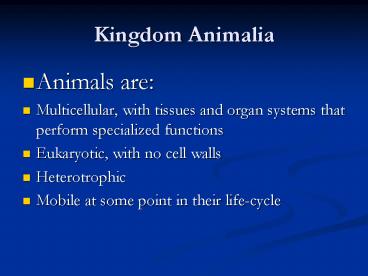Kingdom Animalia - PowerPoint PPT Presentation
1 / 19
Title:
Kingdom Animalia
Description:
Kingdom Animalia Animals are: Multicellular, with tissues and organ systems that perform specialized functions Eukaryotic, with no cell walls Heterotrophic – PowerPoint PPT presentation
Number of Views:336
Avg rating:3.0/5.0
Title: Kingdom Animalia
1
Kingdom Animalia
- Animals are
- Multicellular, with tissues and organ systems
that perform specialized functions - Eukaryotic, with no cell walls
- Heterotrophic
- Mobile at some point in their life-cycle
2
Animal Groups
- Animals are placed into one of two informal
groups for classification purposes - Invertebrates- 95 of animal species are
invertebrates, animals that do not have a
backbone. Everything from insects to squid. - Vertebrates- 5 of animals species, including
mammals, birds, reptiles, amphibians and fish.
3
What Animals Do
- Eat Animals find and eat their food. They can be
carnivorous, herbivorous, omnivorous (both) or
parasitic. Animals can also be filter-feeders and
detrivores (eat dead things.) - Respiration Animals take in oxygen and breathe
out carbon dioxide. - Circulation Most animals have a circulatory
system to move materials within their bodies.
4
- Excretion Most animals have systems to get waste
products like ammonia out of their bodies. - Response Nervous systems within animals allow
them to respond to events in their environment. - Movement Most animals are motile, and have
muscles that contract, allowing them to move. - Reproduction Most reproduction is sexual with
the fusion of haploid gametes, although asexual
reproduction occurs in many invertebrates.
5
Animal Development (p. 661)
- All reproduce sexually, some also reproduce
asexually. - All animal cells originally come from a zygote.
- The first cell divisions of the zygote are called
cleavages. - Several cleavages result in the production of a
small, hollow ball of cells called a blastula - As the cells continue to divide, they push into
the interior - The developing organism becomes a gastrula
6
Development cont
- The gastrula has an opening called the blastopore
- Because each cleavage results in smaller and
smaller cells, the gastrula is usually about the
same size as the original zygote. - During later development of the gastrula, the
cells undergo differentiation.
7
(No Transcript)
8
(No Transcript)
9
Protostome vs. Deuterosome
- Protostome mouth formed from blastopore
- Mostly invertebrates
- Deuterostome anus is formed from the blastopore
and the mouth is formed second. - Echinoderms all vertebrates
10
(No Transcript)
11
(No Transcript)
12
Body Cavities
- Coelom lies between the digestive tract and the
body wall - Important because it provides space in which
internal organs can be suspended - Provide room for internal organs (growth)
- Some cavities have fluids that are involved in
circulation, feeding excretion.
13
Body Symmetry
- The bodies of most animals show some kind of
symmetry - Organisms that lack symmetry are called
asymmetrical - Types of symmetry are spherical symmetry,
radial symmetry, and bilateral symmetry.
14
(No Transcript)
15
(No Transcript)
16
(No Transcript)
17
Spatial Relationships of Bilateral Symmetry
- Front of an animal anterior
- Opposite of the head, or hind end posterior
- Underside ventral
- Opposite of the ventral surface (or back)
dorsal - Medial toward the midline
- Lateral away from the midline (sides)
18
Cephalization
- Most animals with bilateral symmetry
- It is a concentration of sense organs and nerve
cells at the front of the body. - Allows animals to respond to stimuli in a more
advanced way than simple animals
19
- Phyla Chart for invertebrates
- Guided Reading Packet 26-1































